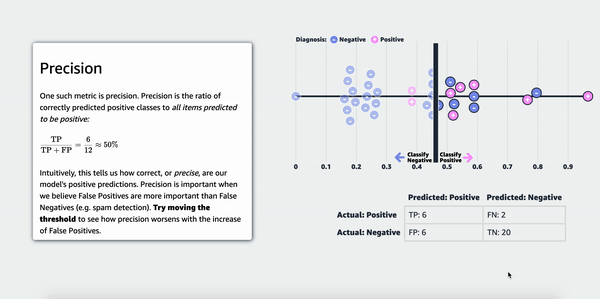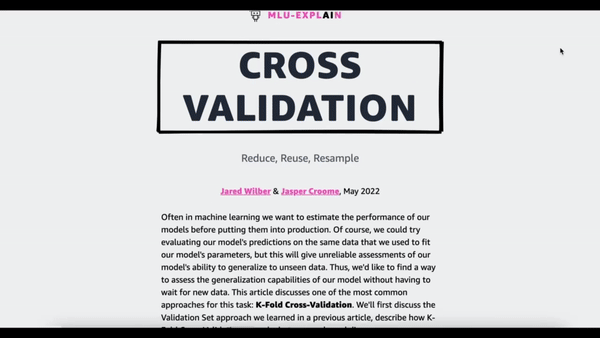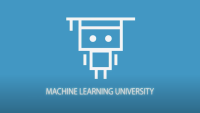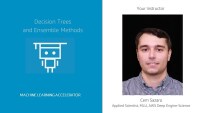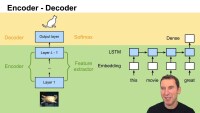Machine learning’s importance to Amazon — and to the world at large — has spurred the need for a large number of people in the workforce to become well-versed in the fundamentals, and to learn how to utilize it for business value.
With that objective in mind, in 2016 the company launched Machine Learning University (MLU) as an in-house educational resource for employees. The classes, taught by Amazon experts, are designed to sharpen the skills of current ML practitioners, while also providing novices the ability to learn to deploy machine learning for their own projects.
Then in 2020 — responding to a growing need for ML education and in an effort to lower barriers for those who want to get started with practical machine learning — Amazon opened those courses to the public.
Jared Wilber, a data scientist who both teaches some of the MLU courses as well as develops fascinating visual explainers for those courses, says the goal is to help people — both seasoned veterans and newcomers alike — learn how to use machine learning in their roles.
MLU classes
“There are so many people who have very strong technical skills, but who don’t know a ton about machine learning,” he says. “So, our goals for MLU are twofold: the first is to teach machine learning to people who have no experience with how it works and how they can use it, and the second is to help people who already have some experience and want to sharpen their skills.”
MLU offers a range of courses, ranging from beginner to advanced, for the general public and for Amazon employees.
These courses use resources such as Amazon datasets, case studies, and AWS tools to help learners create real-world work product. The courses available to the public include topics such as natural language processing, computer vision, tabular data, and decision trees/ensemble methods.
MLU also offers ten advanced courses for Amazon employees; these 36-hour courses are delivered in three-hour blocks for two weeks. Advanced topics include deep learning, reinforcement learning, mathematical fundamentals for machine learning, probabilistic graphical models, and ML production.
MLU Explain
Now, Amazon Web Services has further expanded MLU with MLU Explain, a public website containing visual essays that incorporate fun animations and “scrolly-telling” to explain machine learning concepts in an accessible manner.

“MLU Explain is a series of interactive articles covering core machine learning concepts, and they're meant to provide supplementary material that's educational within a light, but still informative format,” Wilber says. “Currently we have eight articles available, including articles on bias variance trade-off, the random forest algorithm, and two articles on double descent.”
Wilber points out that the second essay of the two-part series on the double descent phenomenon contains novel research by his colleague Brent Werness, MLU’s lead instructor who also is an AWS research scientist.
“That’s an example of something we try to do with every essay: try to present like a little cool thing that is often overlooked, even in textbooks. We ask ourselves, ‘What's something we could add that's often overlooked?’”
One of the MLU visual essays is “The Importance of Data Splitting,” which illustrates the concept of data splitting, or when data is divided into two more subsets. The article uses animations of dogs and cats being separated by species to communicate the concept.

“This is a machine learning model trained in a browser,” Wilber says. “So, if you move the dogs around, such as for the characteristic of ‘fluffiness,’ you can see that the decision boundary moves itself. It’s pretty fun.
“The goal is to make interacting with these systems as unintimidating and fun as possible. We want to make it accessible for everyone.”
MLU Explain articles
The most recent articles posted on MLU Explain include:
- Train, Test, and Validation Sets: This article teaches the concepts of data splitting in machine learning using an example model that attempts to determine whether animals are cats or dogs. The model is live in the browser, and users can explore using the algorithm by dragging the cat and dog icons around.
- ROC & AUC: These are tools to understand an algorithm’s outputs, and to determine an acceptable level of false negatives and false positives. These techniques were first used during World War II to analyze radar signals.
- Precision & Recall: “When evaluating classification models, practitioners need to account for more than just accuracy,” Wilber says. “Precision and recall are two popular alternatives to understand the consequences of your model’s outputs.”
- Random Forest: An article exploring “how the majority vote and well-placed randomness can extend the decision-tree model to one of machine learning's most widely used algorithms, the Random Forest.”
What's next for MLU-Explain?
As for the future of MLU-Explain, Wilber says several new ideas are on the table.
The first is to consider doing deeper dives into certain important machine learning topics, which Wilber calls “high-surface” topics, such as articles on popular algorithms like gradient descent, logistic regression, and neural networks (all currently in development).

“We want to expand the material to cover concepts typically taught in an introductory machine learning course.” This includes covering concepts in new MLU offerings, such as the new course on time series by Lucía Santamaría, an MLU applied scientist based in Europe who also worked on the decision tree visual essay.
After that, Wilber plans to tackle more complex topics.
“We’d like to eventually cover topics pertaining to deep learning, like attention-mechanisms, neural network architectures, etc. MLU has a close relationship with the D2L team [authors of the Dive Into Deep Learning textbook] and we plan to author companion articles to concepts covered in their book — which is amazing, for the record.”
Further down the road, Wilber envisions broadening the set of assets to add self-assessments, open contributions, and even gamification.
“A lot of the algorithms you could think of as a game, where parameters affect game state and outcome,” he observes. “There are definitely opportunities to build on that.”
Wilber sees an opportunity to allow for others to contribute to the effort as well.
“These sorts of interactive documents are difficult to make, so I’ve done my best to make them as easy and open to copy as possible,” he explains. “The code for each article is available open-source, each article references any resources used in its creation, and I’ve created a reusable template for our articles with many of the niceties baked in — so feel free to contribute!”

Whatever the path, Wilber says he hopes these assets can help people both at Amazon and externally learn how to make the best use of a rapidly expanding technology.
All MLU-Explain articles are available for free to anyone seeking to learn more about the machine-learning field. To dive deeper into deep-learning topics, Dive into Deep Learning is an interactive book with code, math, and discussions. The book, which has been adopted by 300 universities in 55 countries, is implemented in NumPy/MXNet, PyTorch, and TensorFlow













